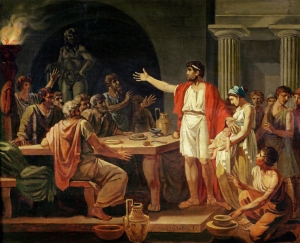#lycurgus
Sparta- Russell’s History of Western Philosophy, chapter by chapter- (12)

Sparta had a profound influence on the subsequent philosophy of Greece through Plato and Aristotle, so Russell takes a chapter to explain their fascinating culture. We will see the politics of Sparta replicated in the Politics of Plato, and even as far in the future as Nietzsche’s thoughts on culture.
Helots
Sparta had no interest in being a part of Greek culture on the larger scale, they were…
The Lycurgus Cup, dichroic glass and metal cup, Late Roman, 4th century AD.
This extraordinary cup is the only complete example of a very special type of glass, known as dichroic, which changes colour when held up to the light. The opaque green cup turns to a glowing translucent red when light is shone through it. The glass contains tiny amounts of colloidal gold and silver, which give it these unusual optical properties. The scene on the cup depicts an episode from the myth of Lycurgus, a king of the Thracians (around 800 BC). A man of violent temper, he attacked Dionysos and one of his maenads, Ambrosia. Ambrosia called out to Mother Earth, who transformed her into a vine. She then coiled herself about the king, and held him captive. It has been thought that the theme of this myth - the triumph of Dionysos over Lycurgus - might have been chosen to refer to a contemporary political event, the defeat of the emperor Licinius (reigned AD 308-24) by Constantine in AD 324. - britishmuseum.
Post link

